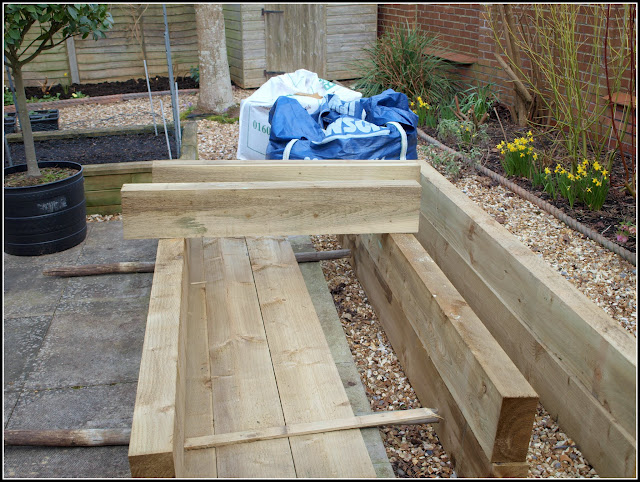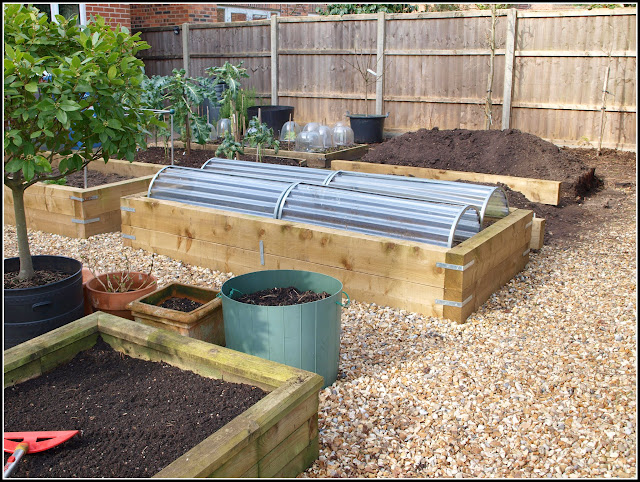Regular readers understand that my garden has to be "Just so". I have a strong OCD streak in me!
Over the years I have progressively upgraded my raised beds, and one day maybe they will be perfect. Yeah, maybe... In the early days, the edging of my beds was made from bits of scrap wood gleaned from old packing-cases and pallets. This was before I took up photography, so I don't have any pictures of that stage.
Those early beds were quite good, but not good enough. For one thing, they were only 6 inches (15cm) tall.
Then I got the Woodblocx bed, which was a big improvement. Hard work to assemble, but definitely worth it. Nice and deep too.
Last year (2015) many of the beds needed replacing again and I decided on a pattern that has a depth similar to the Woodblocx one - 40cm. It also has the benefit of simplicity of construction, which the Woodblocx bed definitely did not have.
The timber is supplied as "sleepers", each 240cm x 20cm x 10cm. It is still softwood though, not like the iron-hard stuff that proper old railways sleepers used to be made of. I made two of these beds last year. They performed very well. The one in the photo above produced the best crop of carrots I have ever had. Of course part of the success was due to the Enviromesh cover which I put over the bed.
The regular shape of the beds and the tall sides make it easy to erect a suitable framework for the netting:
The framework is made from plastic "Build-a-Ball" balls, with lightweight aluminium rods purchased from a company called Gardening Naturally. This has proved to be a very efficient and versatile combination.
Coincidentally, the dimensions of the beds are perfect to accommodate my four "Longrow" tunnel cloches:
This year, as you know, I have committed to building another two of these big deep beds.
 |
| Some of the sleepers have to be cut in half to make the end pieces. |
I'm not sure yet what is happening about the remaining two. Maybe I'll do them later this year (I'll have more time to spare after I retire), or maybe I'll leave them till next year. Finances are a consideration too: each of those beds comes in at about £157, and I may not be able to justify spending that sort of money when my income drops dramatically! [If you want to see the exact costings, I wrote about these last year, HERE.]
Anyway, I've just remembered that I was supposed to be saying why I like raised beds so much, so here goes:
1. They keep the garden neat and tidy (in particular, they stop the Blackbirds kicking compost all over the place!)
2. They allow me to concentrate all available compost / fertiliser / water etc on the productive parts of the garden, without wasting any on unproductive areas
3. The added depth gives the vegetables more room to put down big roots
4. The soil in the beds warms up quicker in the Spring
5. Being above ground level, the beds never get waterlogged
6. It is easier to protect plants in the beds, using nets, mesh, fleece etc supported on the sort of framework described above








I see, you've been busy with your new raised beds. I laughed when you said you have a strong OCD streak in you. And yes, we understand and love your garden. I really envy you because you can work in the garden at this time. I still cannot do anything because of the rain. The rain is now really annoying and I hope it will stop soon. I wanted to sow the peas but the ground was too wet for the job. I have only pruned my Wisteria last Saturday.
ReplyDeleteOn our allotment site many people start with what they call raised beds but are really wooden edged beds and these are often discarded as they rot (cheap wood) or are difficult to weed around. Spending the amount you have on a plot is something most people won't consider as it is a rented space. In your situation and with true raised beds it's a totally different proposition. We really like our Woodblocx bed.
ReplyDeleteYes, these have become very popular on our allotments too. As you say, they are usually not constructed properly as raised beds & are mostly intended as a means of reducing the amount of plot that needs cultivating, with the chipping-covered paths between the beds taking up most of the space.
DeleteYour gardens always looks well. Its good to read about your evolving raised beds and the cost etc. I'm in the market for some "Build-a-Ball" type lightweight aluminium rods so your post was quite timely.
ReplyDeleteI started gardening in raised beds because our soil was so incredibly rocky. And I love them! I doubt I would ever create a vegetable garden any other way. And I have two more benefits to add to your list - (1) You never step on and compact the soil, which is better for both the soil and the plants and (2) all that loose, friable soil & the height of the beds makes weeding a lot easier!
ReplyDeleteHi Mark thanks for the raised bed update. Would you say then that the DIY sleeper bed was the way to go rather than the Woodblocx bed? Mine are going on a patio but I am doing them by myself so really need something that's not too taxing to put together!
ReplyDeleteWell, I think my pattern is really easy to construct. The Woodblocx stuff is "higher quality" and the timber will probably last longer, but it does need a certain amount of skill / effort to construct.
DeleteThank you, I think yours looks very straightforward and t'others are rather expensive - that plus fiddly does rather put me off!!
DeleteAlso a big fan of the raised box bed, Still making mine out of relatively inexpensive 1"x8"x8' pine boards. They last about 5 years works out to about $1/year per board
ReplyDeleteI'm a big fan of raised beds too, and I really like your latest versions. I have a couple of wooden ones, but cost is an issue – especially when they inevitably wear out. So I'm building some more out of old kerbstones we had lying around the garden. The first one is done, so look out for a post about it soon.
ReplyDeleteI switched to raised beds because the garden soil was so poor and was frequently flooded. Plus gardening in raised beds is so much easier. Some benefits to add to yours and Margaret's:
ReplyDelete1) The beds encourage planting in blocks rather than rows which is more efficient of space
2) Garden planning is easier because the configuration is known and fixed and I plant in blocks or "squares".